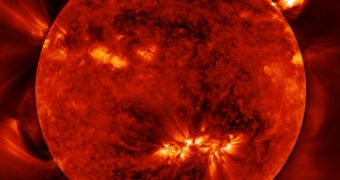Over the years, a large number of Sun-observing telescopes have been launched to various orbits, but there was always a certain portion of the star's super-hot atmosphere that evaded analysis. Using the most recent NASA observatory, studying the solar layers is now easier than ever before.
The American space agency launched the Solar Dynamics Observatory (SDO) as part of its Living with a Star program. The spacecraft was ferried to orbit aboard the Atlas V 401 delivery system from the Space Launch Complex 41 at the Cape Canaveral Air Force Station (CCAFS), in Florida.
It took off on February 11, 2010, and it's scheduled to remain active for between 5 and 10 years. The observatory features three main instruments, the Helioseismic and Magnetic Imager (HMI), the Extreme Ultraviolet Variability Experiment (EVE) and the Atmospheric Imaging Assembly (AIA).
What makes the SDO more efficient in solar studies than other telescopes is the fact that it can analyze the star's corona, the outer layer of its atmosphere. This region of the Sun is interesting because it is several times hotter than the actual surface.
Solar physicists have been wondering about the reason why this happens for years, and it was only recently that SDO data cleared the mystery.
The solar atmosphere is, on average, millions of degrees hotter than the surface. Experts have over the past few decades proposed a variety of explanations to make sense of this, but none of the theories was ever backed up by conclusive evidence.
In the new study, scientists conducted direct observations of the processes that heat up the atmosphere, and were able to determine that jets of plasma emanating from the surface of the Sun play a huge role in maintaining the blistering temperatures.
Such plasma jets, the team behind the new research says, are emitted from the surface at supersonic speed, and they represent the primary mechanism through which the solar atmosphere stays hot.
According to the lead researcher on the new study, expert Bart De Pontieu, these jets are in fact “long, elongated fin features at the edge of the Sun.” Scientifically, they are called spicules, Space reports.
“We can follow the corona all the way down to the Sun's surface,” explained in a statement Leon Golub, who is based at the Harvard-Smithsonian Center for Astrophysics (CfA).
“The AIA solar images, with better-than-HD quality views, show magnetic structures and dynamics that we've never seen before on the Sun. This is a whole new area of study that's just beginning,” adds CfA astronomer Steven Cranmer.

 14 DAY TRIAL //
14 DAY TRIAL //